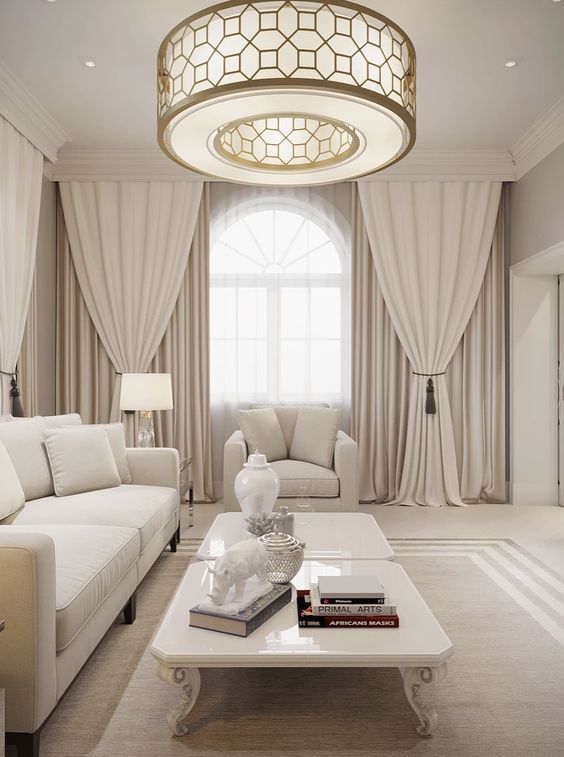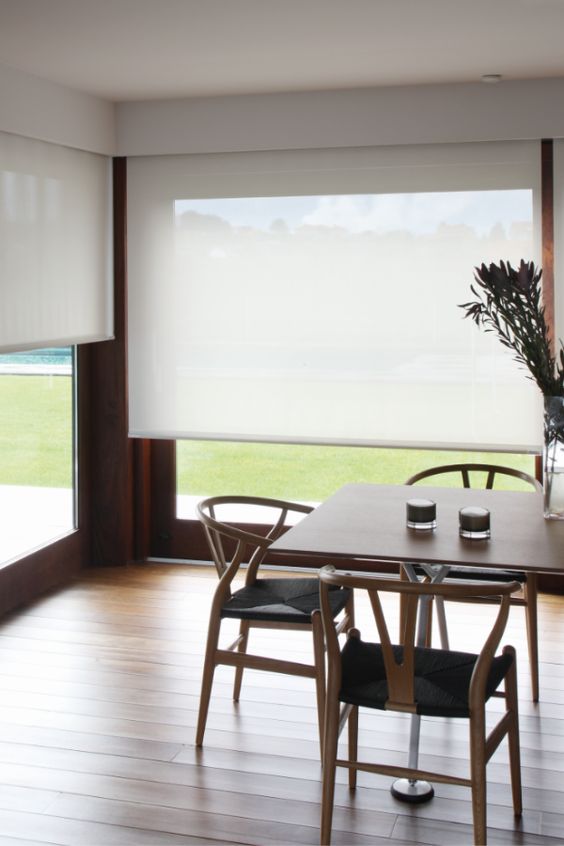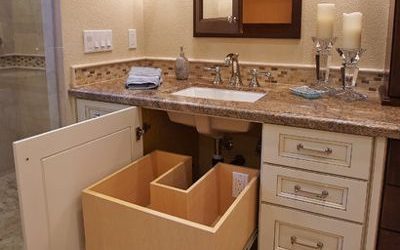
Source: Rug’Society
A window treatment refers to any decorative or functional covering or adornment applied to a window. Window treatments serve various purposes, including controlling the amount of light entering a room, ensuring privacy, and enhancing the overall aesthetic of the space. These coverings come in a variety of styles, materials, and designs, allowing for customization based on both practical and decorative considerations.
Common types of window treatments include curtains, drapes, blinds, shades, shutters, valances, cornices, sheers, and various combinations of these elements. The choice of window treatment depends on factors such as the desired level of privacy, light control, the overall design style of the space, and individual preferences.
-
Here are various window treatment options commonly used in interior design:
1. Curtains and Drapes:
-
- Fabric Choices: Curtains and drapes come in a wide range of fabrics, from lightweight sheers to heavy velvets. The choice of fabric can impact the level of privacy, light control, and overall style.
-
- Styles: Curtain styles vary, including rod-pocket, grommet, pinch-pleat, and more. The style of curtains can influence the formality or casualness of the room.

Source: Etsy
2. Blinds:
- Horizontal Blinds: These consist of slats that can be tilted to control the amount of light entering the room. Common materials include wood, faux wood, aluminum, and vinyl.
- Vertical Blinds: Vertical slats are often used for large windows or sliding glass doors. They can be tilted or drawn to the side for light control and privacy.
Blinds come in various materials, styles, and colors, making them suitable for a wide range of design aesthetics. Here are some key aspects of blinds as a window treatment:
- Materials:
- Wood Blinds: Offer a warm and natural look. They are available in various wood types and finishes.
- Faux Wood Blinds: Mimic the appearance of real wood but are made from composite materials. They are durable and resistant to moisture, making them suitable for areas like kitchens and bathrooms.
- Aluminum Blinds: Lightweight and cost-effective, aluminum blinds come in a variety of colors and are often used in modern and industrial-style interiors.
- Fabric or Vinyl Vertical Blinds: Vertical blinds are composed of individual slats that run vertically. They are commonly used for large windows or sliding glass doors.
- Styles:
- Horizontal Blinds: The slats run horizontally, and they can be raised or lowered to control light. Tilt controls allow for adjusting the angle of the slats for privacy and light control.
- Vertical Blinds: Designed with vertical slats that can be drawn to the side. They are often used for wide windows or as a practical solution for sliding glass doors.
- Light Control and Privacy:
- Blinds offer excellent control over both light and privacy.
- By adjusting the angle of the slats or raising/lowering the blinds, you can customize the amount of natural light entering the room.
- Versatility:
- Blinds are versatile and can be adapted to various design styles. They work well in both contemporary and traditional settings.
- Ease of Maintenance:
- Blinds are relatively easy to clean and maintain. Dusting or wiping the slats with a damp cloth is typically sufficient for routine maintenance.
- Motorized Options:
- Modern blinds often come with motorized options that allow you to control them remotely.
- This adds a level of convenience and is especially useful for hard-to-reach windows.
- Integration with Other Treatments:
- Blinds can be used alone or in combination with other window treatments, such as curtains or valances, to create a layered and textured look.

Source: Blinds 2go
3. Shades:
- Roller shades consist of a single piece of fabric that can be rolled up or down using a cord mechanism or a spring-loaded system.
- Functionality: They are versatile and provide a clean, contemporary look. Roller shades come in a variety of fabrics, including light-filtering, blackout, and sheer options.
- Roller Shades: These are simple, versatile, and can be customized with various fabrics and patterns. They roll up and down to control light and privacy.
- Roman Shades: Soft fabric shades that fold into pleats when raised. They provide a tailored and elegant look.
- Cellular or Honeycomb Shades: These have a unique honeycomb structure that provides insulation, making them energy-efficient. They come in various opacities for light control.

Source: helloalva.com
4. Shutters:
a) Types of Shutters:
-
- Plantation Shutters: These are perhaps the most common type of shutters. Plantation shutters have wide louvers (slats) and are often hinged on the sides of the window frame. They can be adjusted to control light and privacy.
- Café Style Shutters: These cover only the lower portion of the window, leaving the upper part open. They offer privacy while allowing natural light to enter the room.
- Solid Panel Shutters: Instead of louvers, these shutters have solid panels that cover the entire window. They are more traditional and provide maximum privacy and light blockage when closed.
b) Materials:
-
- Wooden Shutters: Traditional and classic, wooden shutters are often made from hardwoods like oak or poplar. They can be stained or painted to match the interior decor.
- Composite Shutters: Made from engineered wood or MDF (medium-density fibreboard), composite shutters offer durability and resistance to humidity and temperature changes.
c) Aesthetic Appeal:
-
- Shutters add a sense of sophistication and elegance to a space. They have a clean and structured appearance that works well in various design styles, from traditional to contemporary.
d) Light Control and Privacy:
-
- Louvered shutters provide excellent control over natural light and privacy. By adjusting the angle of the louvers, occupants can customize the amount of light entering the room while maintaining privacy.
e) Ventilation:
-
- Plantation shutters, with their adjustable louvers, allow for ventilation. The louvers can be opened partially to let in fresh air while maintaining privacy.
f) Easy Maintenance:
-
- Shutters are relatively easy to clean and maintain. Regular dusting or wiping with a damp cloth is typically sufficient to keep them looking fresh.
g) Insulation:
-
- Wooden shutters, in particular, can contribute to insulation. They provide an additional barrier against heat and cold, helping to regulate indoor temperatures.
h) Customization:
-
- Shutters can be customized to fit a wide range of window shapes and sizes. Customization options also include paint or stain finishes, allowing for coordination with the overall color scheme.
i) Longevity:
-
- Well-maintained shutters can last for many years. Their durability and timeless style make them a long-term investment in the interior design of a home.

Source: Carol Clem
5. Valances and Cornices:
-
- Valances: Fabric or wood treatments that cover the top portion of the window. They can add a decorative touch without obstructing the view.
- Cornices: Wooden or fabric-covered boards mounted at the top of the window to add a decorative element and hide curtain hardware.
6. Sheers:
-
- Sheer Curtains: Lightweight, translucent curtains that allow diffused light into a room while providing a level of privacy. They add an ethereal and soft look to windows.
7. Layered Treatments:
-
- Combining different window treatments, such as blinds with curtains or sheers, allows for greater flexibility in light control and adds visual interest.
8. Motorized and Smart Solutions:
-
- Motorized window treatments, controlled by remote or smart home systems, offer convenience and precision in adjusting light and privacy levels.

Source: lovelight.com.au
Conclusion
When choosing window treatments, consider the function of the space, the amount of natural light, the desired level of privacy, and the overall design aesthetic. Additionally, the color, pattern, and texture of the window treatments should complement the rest of the room. Customizing window treatments to fit the specific needs of each window and room is a common practice in interior design.
Your Title Goes Here
Your content goes here. Edit or remove this text inline or in the module Content settings. You can also style every aspect of this content in the module Design settings and even apply custom CSS to this text in the module Advanced settings.

About Author apurva nagure
Your Title Goes Here
Your content goes here. Edit or remove this text inline or in the module Content settings. Your content goes here.
.
You May Also Like…
“Sinks that Wow: A Guide to Bathroom Sink Designs”
Source: behance.netYour bathroom is more than just a utilitarian space; it's a canvas for personal expression and...
Sustainability In Interior Design
As the world shifts towards a more environmentally aware mindset, the concept of sustainability has become integral to...
Your Title Goes Here
Your content goes here. Edit or remove this text inline or in the module Content settings.



